A big test of small antennas for amateur handheld radios 2m / 70cm
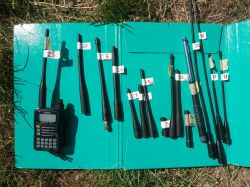
Hello everyone.
Recently, I have measured several dozen handheld antennas and 3 car antennas in the amateur 2m and 70cm ranges in an amateur way.
Here is the list:
| 01 | Retevis RHD771 (2.15dBi) | Aliexpress RETEVIS Official Store |
| 03 | Nagoya NA-771 (2.15dBi) | Aliexpress? |
| 07 | Yaesu VX-6R | Factory attached to the radio |
| 08 | Wouxun KG-UV8D | Factory attached to the radio |
| 09 | Harvest RH660S (3.0 / 5.0 dBi) | Aliexpress BlueRadio store |
| 09skr | as above but it was only extended to work at 70 cm partially so that the SWR is approx. | as above |
| 10 | Self-made on the pattern 771 | Sam robilem |
| 11 | Diamond NR-770H (3.0/5.5dBi) | InRadio |
| 12 | Nagoya NL-770H (3,0/5,5 dBi) | HamRadioShop |
| 13 | Nagoya NL-770R (3,0/5,5 dBi) | HamRadioShop |
| 14 | Nagoya NA-666 (2.15 dBi) | ? |
| 15th | Nagoya NA-771 (2.15dBi) | ? |
| 16 | Baofeng BFG-A-3 | ? |
| 17 | Baofeng UV-3 | Fabryczna dołączona do radiotelefonu |
| 18 | ICOM FA-S270C | Factory attached to the ICOM E90 radio |
| 19 | Baofeng DM5 | Factory attached to the radio |
| twenty | Baofeng UV5 | Factory attached to the radio |
| 21 | Nagoya NA-771 | ? |
| 22 | Kenwood KRA-23M | factory included with the NX-200 radio |
| 23 | Kenwood TH-D74 | Factory attached to the radio |
| 24 | Yaesu FT-5D | Factory attached to the radio |
| 25 | Anytone 878 | Factory attached to the radio |
| 26 | Alinco DJ-G7 | Factory attached to the radio |
| 27 | Yaesu VX-2 | Factory attached to the radio |
| 28 | ICOM MARINE? | Factory attached to the marine radiotelephone |
| 29 | Kenwood NX-320 E2 (KRA-27?) 70cm | Factory attached to the radio |
| thirty | ? Miniature something at 70cm | Aliexpress |
| 31 | Sagem 70cm | ? |
| 32 | Yaesu Standard Horizon CAT-460 | Factoryattached to the radio |
| 33 | MDVM HS DUAL | Factory attached to the hotspot |
| 35 | Diamond RH-771 | ? |
| 36 | Nagoya NA-771 | ? |
| 37 | Nagoya NA-701 | ? |
| 38 | ? without description, base similar to Wouxun | ? |
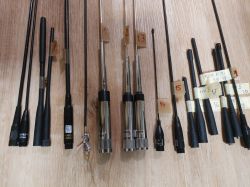
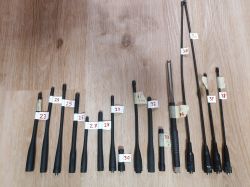
The measurement was carried out in 4 rounds, in which I measured the S1P parameters (including SWR) and the signal level emitted from each of the antennas under field conditions.
S1P measurements with the NanoVNA-H4 analyzer:
1. Antenna placed directly on the NanoVNA-H4, and measurement with the Analyzer in the hand, close to the head, held like a handheld transceiver.
NanoVNA calibration took place directly on its socket in the frequency ranges 120 to 170 MHz and 400 to 470 MHz
2. Antenna on the base with counterweights and NanoVNA measurement.
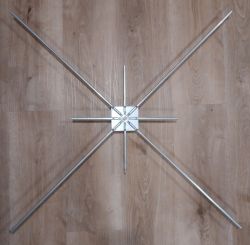
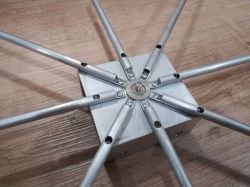
NanoVNA calibration was done on the base slot, eliminating the influence of the adapters used to connect the base. Ranges as above. If the antenna required an additional adapter, then this adapter was not calibrated, so the SMA barrel extends the line by 155 picoseconds, and the SMA - UC1 socket is 327 picoseconds, and this UC1 adapter has 43 ohms of wave impedance. The influence of these adapters is noticeable in the 70cm band, especially on the Smith chart, but it is not big and for the purposes of this test it can be omitted.
Signal level measurements:
3. Antenna on Yaesu VX-6 handheld radio and signal level measurement on base station.
4. Antenna on a base with counterweights and a base on a Yaesu VX-6 and measuring the signal level on the base station.
Measurements 3 and 4 were carried out at a distance of 185 meters from the base antenna, in an urban area, in a densely built-up housing estate, but in the field of optical visibility of the antennas. I walked about 15 meters with the PTT pressed at full power and the device at my head, just like I would normally use it to make communications. I tried to keep the device as vertical as possible so that the polarities of the antennas were consistent. There were no obstacles on the walking route in the immediate vicinity. In the case of walking with the counterweight base, these counterweights were placed a few cm above the head, so then the antenna was about 30cm higher than when broadcasting without counterweights, which could have a false positive effect in favor of the counterbalance system.
At the base station, the signal was picked up by a Diamond X50N antenna installed about 10 meters higher than the towel rail, giving an angle of 3.1 degrees. The signal came through a 10 dB attenuator, an RTL-SDR tuner working with the SDR ++ application, set to minimum gain, all AGC off, sampling 1536 kHz, division / 8 giving 192 kHz. The spectrum was recorded to an IQ .wav file. The center frequency of the SDR was set 50 kHz higher than the handheld transmitter, and as a result, the recording showed a carrier signal with a frequency of 50 kHz. The recording was filtered with a 49 kHz - 51 kHz bandpass filter. After such a cleaned recording, the noise level was -59 dB. 0dB is the SDR overload level, so the results are in the range of -59 dB is the minimum level to 0 dB is the maximum level (they are negative).
Each antenna transmitted for about 15-20 seconds, and from this time the average RMS level expressed in dB was calculated.
An example recording chart opened in an audio processing program looks like this:

There are clear differences between the individual antennas. I've already selected sample 35 on it, then zoom in:
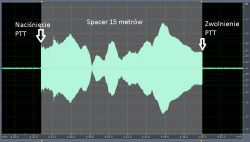
and I mark precisely the beginning and the end. You can see here that the signal level fluctuates as it travels. Then I use the statistical analysis function which gives me this information:
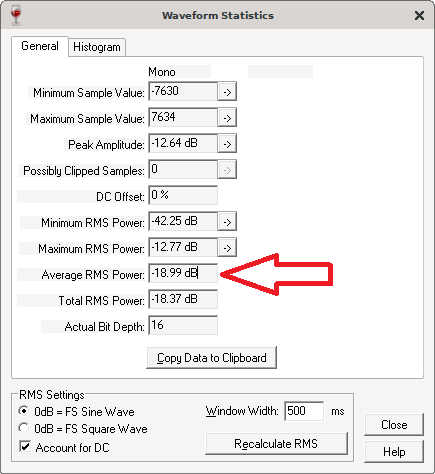
I am writing back Average RMS Power.
The measurements with the hand towel were performed on the frequencies 144.9875 MHz and 434.9875 MHz.
Measurements made from antenna No. 14 took place only without counterweights.
Results for the 2m band:
| number | Antenna | Signature level out of hand | SWR out of hand | Impedance | Signal on counterweights | SWR from pw | The impedance from the |
| 01 | Retevis RHD771 | -22.24 | 4.10 | 29.55 -55.18i | -13.27 | 5.31 | 10.23-14.47i |
| 03 | Nagoya NA-771 | -21.94 | 3.83 | 49.01-71.55i | -12.63 | 3.66 | 15.37-16.83i |
| 07 | Yaesu VX-6R | -25 | 4,61 | 29,72 -61,55i | -19,7 | 5,74 | 09,87 -17,92i |
| 08 | Wouxun KG-UV8D | -26,5 | 7,11 | 31,67 -89,32i | -26,91 | 18,19 | 06,68 -59,56i |
| 09 | Harvest RH660S | -9,88 | 1,02 | 50,73 00,60i | -7,82 | 1,07 | 52,39 -02,17i |
| 10 | Samoróbka 771 | -18,52 | 1,22 | 57,99 06,95i | -17,91 | 6,95 | 166.82 -169,83i |
| 11 | Diamond NR-770H | -8 | 1,23 | 51,12 10,63i | -6,44 | 1,16 | 48,04 07,10i |
| 12 | Nagoya NL-770H | -11,59 | 1,79 | 68,49 -29,26i | -9,59 | 1,78 | 64,28 -29,83i |
| 13 | Nagoya NL-770R | -8,36 | 1,52 | 33,20 -03,87i | -6,55 | 1,41 | 36,06 04,67i |
| number | Antena | Poziom sign. z ręki | SWR z ręki | Impedancja |
| 14 | Nagoya NA-666 | -30,18 | 7,85 | 26,56 -85,99i |
| 15th | Nagoya NA-771 | -21,19 | 1,92 | 59,32 -34,85i |
| 16 | Baofeng BFG-A-3 | -26,68 | 3,00 | 18,05 13,46i |
| 17 | Baofeng UV-3 | -28,78 | 4,43 | 17,65 -35,98i |
| 18 | ICOM FA-S270C | -26,87 | 3,96 | 31,44 -56,04i |
| 19 | Baofeng DM5 | -24,97 | 1,88 | 27,22 -06,15i |
| 20 | Baofeng UV5 | -27,9 | 3,04 | 20,18 -22,07i |
| 21 | Nagoya NA-771 | -24,68 | 3,79 | 43,70 -66,72i |
| 23 | Kenwood TH-D74 | -28,34 | 6,33 | 30,94 -81,16i |
| 24 | Yaesu FT-5D | -23,54 | 1,13 | 53,18 -05,61i |
| 25 | Anytone AT-D878 | -24,11 | 1,37 | 43,23 -13,06i |
| 26 | Alinco DJ-G7 3pasma | -26,69 | 3,63 | 69,47 -78,97i |
| 27 | Yaesu VX-2 | -25,88 | 1,90 | 43,98 -29,96i |
| 28 | ICOM MARINE | -29,62 | 7,75 | 27,11 -86,30i |
| 32 | Yaesu Standard Horizon | -29.99 | 11,44 | 23,36 -102,08i |
| 34 | Astro 320 127cm | -14,99 | 2,59 | 96,68 -50,43i |
| 35 | Diamond RH-771 | -18,99 | 1,72 | 85,63 05,67i |
| 36 | Nagoya NA-771 | -21,79 | 3,61 | 49,37 -68,29i |
| 37 | Nagoya NA-701 | -24,08 | 3,09 | 40,51 -52,58i |
| 38 | Wouxun? | -22.1 | 1.99 | 79.59 32.86i |
Due to the fact that the negative units of the signal level are not very intuitive, for the purposes of the graph, I added +31 dB to each antenna so that all the results were positive.

Results for the 70cm band:
| number | Antenna | Signature level out of hand | SWR out of hand | Impedance | Signal on counterweights | SWR from pw | The impedance from the |
| 01 | Retevis RHD771 | -11.83 | 1.57 | 64.47 21.41i | -14.45 | 1.66 | 63.37 25.36i |
| 03 | Nagoya NA-771 | -15.59 | 2.47 | 99.53 -43.50i | -15.25 | 2,01 | 91,23 -24,50i |
| 07 | Yaesu VX-6R | -19,44 | 3,27 | 36,61 -51,99i | -18,64 | 4,53 | 14,80 -28,28i |
| 08 | Wouxun KG-UV8D | -18,59 | 3,31 | 108,81 -72,83i | -14,2 | 1,23 | 59,70 05,76i |
| 09 | Harvest RH660S | -14,54 | 1,31 | 63,95 -06,13i | -14,62 | 1,37 | 64,10 -10.95i |
| 09skr | Harvest RH660S skrócona | -14,02 | 1,01 | 49,35 00,10i | -13,79 | 1,04 | 51,90 -00,49i |
| 10 | Samoróbka 771 | -11,98 | 1,27 | 39,66 -01,93i | -13,13 | 1,45 | 34,67 02,63i |
| 11 | Diamond NR-770H | -11,21 | 1,06 | 51,88 02,60i | -10,52 | 1,22 | 42,50 -05,09i |
| 12 | Nagoya NL-770H | -13,61 | 1,63 | 30,6101.14i | -11.59 | 1.85 | 27.22 -03.46i |
| 13 | Nagoya NL-770R | -20.55 | 2.36 | 50.72-44.59i | -13.86 | 2.51 | 27.21 -26.67i |
| number | Antenna | Signature level out of hand | SWR out of hand | Impedance |
| 14 | Nagoya NA-666 | -19.85 | 5.82 | 121.36-138.41i |
| 15 | Nagoya NA-771 | -18.07 | 5.02 | 244,36 -39,54i |
| 16 | Baofeng BFG-A-3 | -20,47 | 1,70 | 55,85 -27,88i |
| 17 | Baofeng UV-3 | -17,28 | 1,20 | 54,95 07,97i |
| 18 | ICOM FA-S270C | -22,52 | 3,38 | 30,10 -46,16i |
| 19 | Baofeng DM5 | -16,61 | 1,72 | 85,59 05,65i |
| 20 | Baofeng UV5 | -16,63 | 1,74 | 83,53 -13,37i |
| 21 | Nagoya NA-771 | -21,74 | 6,69 | 23,39 -70,37i |
| 22 | Kenwood KRA-23? | -18,64 | 2,06 | 70,31 -38,90i |
| 23 | Kenwood TH-D74 | -22,65 | 3,07 | 38,17 -50,25i |
| 24 | Yaesu FT-5D | -23,28 | 3,90 | 27,32 -49,26i |
| 25 | Anytone AT-D878 | -17,8 | 1,95 | 76,32 -32,73i | 26 | Alinco DJ-G7 3pasma | -23,07 | 2,42 | 40,57 -40,08i |
| 27 | Yaesu VX-2 | -22,47 | 2,70 | 43,26 -47,67i |
| 29 | Kenwood KRA-27? | -20,22 | 2,46 | 54,49 -48,29i |
| 30 | Miniaturowa | -22,68 | 1,84 | 51,83 -31,57i |
| 31 | Sagem 70cm | -21.9 | 3,71 | 183,21 -18,91i |
| 33 | MMDVM HS DUAL | -19,83 | 1,39 | 47,75 16,04i |
| 35 | Diamond RH-771 | -14,83 | 1,18 | 55,47 -06,71i |
| 36 | Nagoya NA-771 | -18,74 | 3,49 | 39,18 -57,91i |
| 37 | Nagoya NA-701 | -20,41 | 3,66 | 48,98 -68,74i |
| 38 | Wouxun? | -19,08 | 3,19 | 57,18 -65,15i |
Tu również dodałem +31 dB.

Conclusions:
- The handheld radio must be able to withstand a very high SWR.
- Handheld antennas of an acceptable length work much better in the 70 cm band than in the 2 m band.
- The difference in the signal level in the 2m band between the weakest antenna and the strongest one was 23.72dB. So we would have to use 236 watts from the weakest antenna to get the same signal level from 1 (ONE) watt from the strongest. For the record decibel calculator
- The typical "gain" of a handheld antenna in the 2m band is strongly negative and is in the range of -10 to -20 dBi.
- Counterweights help greatly in the 2m band, while their use with a towel is impractical.
- Telescopic antennas, especially the long ones, are very effective, but they break down quickly and can crackle. Example of Astro 320:
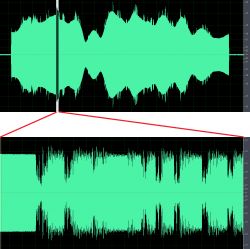
Finally, here are the Smith and SWR charts:
01 03 07:



08 09 10:


11 12 13:



14 15 16:



17 18 19:



20 21 22:


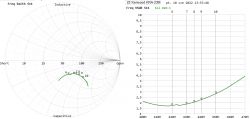
23 24 25:



26 27 28:


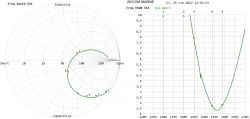
29 30 31:
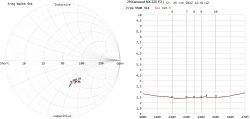
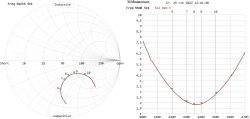
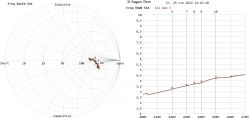
32 33 34:

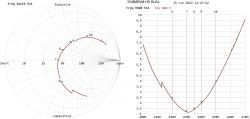
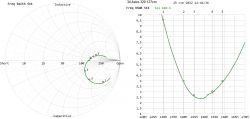
35 36 37:



38:

I wish you distant communications
djbpm



Comments
You know, I've read a bit about antennas, I get the decibels, I even have NanoVNA and can roughly use it. I studied your text three times before I understood enough to figure out what the author meant. ... [Read more]
"How did you impress me" :) Now I am asking for a summary in Polish :) Now, as a less advanced one, I will ask which antenna for "baofeng" on 2m would you recommend? Regards [Read more]
From the author's comparison of 2 m, the best antenna is No. 11, ie Diamond NR-770H -> the variant without counterweights gives us as much as -8 dBFS on the receiver, with SWR = 1.23 (which is decent... [Read more]
Now that you know what's going on, maybe you can help write it in a simpler way? This is my first entry of this type, I am not a Polish teacher. I did not want this analysis to go to waste and only... [Read more]
Congratulations on your willingness to conduct research. [Read more]
Very good job, hats off :) [Read more]
Good job :) Interesting results, although in some cases predictable ;) Once Jarek SP3SWJ took measurements with his MAX 6 and the results were also interesting :) A big plus, because after all, it's... [Read more]
Predictably, but you were hoping to find something sensible up to half a meter. I tried to measure similarly and in the case of hand antennas it does not work, because the cables become a counterweight,... [Read more]
All in all, as I mentioned once, the measurements of Jarek SP3SWJ were visible, I accepted it myself and use Nagoya 701 (the stick knows if they are originals or fakes). Mainly due to the fact that a... [Read more]
Do you know what I miss in this statement? Something as trivial as a tuned quarter-wave piece of wire just soldered into a plug. [Read more]
Yes - such a simple basic antenna for comparison, such a simple "quarter". [Read more]
The reference antenna is usually a half-wave dipole. But maybe I will test something else. There will be what, there will be time, why not. Such a quarter is easy to make, but the quarters work very poorly... [Read more]
In the past, there were probably fewer fakes, now it is difficult to know what is original ... This NA-701 like the original bought in a store in PL where the seller claimed that the original (has a... [Read more]
Due to the fact that some people use stationary analyzers and try to connect manual antennas to such an analyzer with cables, I also did a test of how the antenna behaves when connected via a cable. Two... [Read more]